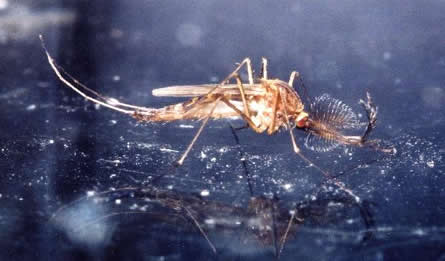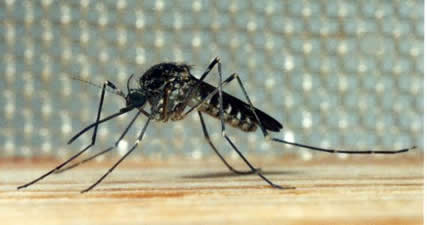

Introduction to the Mosquitoes of British Columbia

Culex pipiens, a male of one of the species known to transmit West Nile virus.
Photo by Peter Belton
by
Peter Belton
Biological Sciences (Retired)
Simon Fraser University
Read about BC Mosquitoes as Vectors of West Nile Virus
Mosquitoes are well known insects and most of their characteristics are described in the introduction to their Order, the Diptera. They are a successful group, surviving in their present form, presumably with similar behaviour, for 100 million years or more. The reason might be because they exploit a wide variety of habitats for their air breathing immature stages, from a small rot cavity in a tree to the swampy expanses of the Arctic tundra. The adults also fill a variety of niches, from the seashore and river banks to the mountain tree lines. We have 48 confirmed species and subspecies in the Province and another 14 are known from adjacent territories just across our borders (click here for more details).
When ancestral mosquitoes moved into colder climates, the adults probably changed their physiology in winter, slowing their metabolism so that they could hibernate. Most mosquitoes in the genera Anopheles, Culex and Culiseta do this in our Province. At the end of the season, they mate and the females accumulate enough fat to keep them alive over winter and provide enough energy for them to fly from their hibernation sites the following spring to seek a blood meal, after which they develop and lay a batch of about 100 fertile eggs.

Culiseta incidens. Photo by Peter Belton
In contrast, most members of our largest genus, Aedes, have developed eggs that can survive winter temperatures. If they are not flooded, the eggs can survive for several seasons without hatching even in the arctic. Both males and females emerge from the immature stages that hatch from eggs flooded under the right conditions. A few of our Aedes species at the northern limit of their distribution can overwinter as fully grown larvae in rock pools and tree cavities, but none can survive the winter as adults.
Unique among our mosquitoes is Mansonia perturbans, the only member of its genus to reach Canada, whose larvae and pupae are adapted to pierce the air-filled roots of cat-tails and similar aquatic plants. They overwinter as larvae still attached to the plant at least as far north as Prince George where swamps and marshes must be almost entirely frozen.
Soon after they emerge, males of many species form large swarms at dusk and dawn and females fly in and mate before starting their search for a blood meal. Males are relatively short-lived but females receive enough sperm in one mating to fertilize several batches of eggs. Females may take several bloodmeals and mature and lay several clutches of eggs if they survive long enough. Several species are multivoltine (i.e. they can produce more than one generation each year).
It seems likely that the first insects to feed on blood picked up some of the parasites circulating in the host (there is convincing evidence that alien cells must have lived in other hosts before they became multicellular). Mosquitoes are now responsible for transmitting more human disease than any other blood feeding animal; malaria alone infects about 500 million people each year.
In British Columbia, there are many mosquito-borne diseases in nature. Heartworm is transmitted to members of the dog family, malaria specific to birds, and viruses in a variety of mammals are probably only a few of those identified. So far there have been no significant outbreaks of mosquito-borne diseases in humans in the Province although people in the north have been exposed to California encephalitis virus, with few symptoms, and there have been some cases of the bird-borne Western Equine Encephalomyelitis virus in humans and horses in the dry interior.
Bird-borne viruses can seem to appear from nowhere and spread rapidly. West Nile virus (WNv) has spread faster than any other known human disease since it arrived in North America, probably in a bird imported to New York in 1999. It is now known from all 48 contiguous United States and 7 Canadian Provinces. It may just be a matter of time before WNv arrives in British Columbia because it has been found in the States of Washington, Idaho and Montana and across the Rockies in Alberta. We have two very capable vectors of WNv, Culex tarsalis and Cx. pipiens . There are distributed across the southern half of the Province including Vancouver Island (Stephen et al. 2006). Fortunately our Ministry of Health has funded surveys of mosquitoes in much of the Province. Trapped mosquitoes and dead corvids (i.e., Crows, Jays, Magpies and Ravens)--evidently victims rather than vectors of the virus--are being tested for WNv. The sites that contain larvae and pupae of these species are being mapped, and controlled with a bacterial toxin in some jurisdictions. A vaccine is available for horses, which are also very susceptible to the virus, but it is not yet considered safe enough to vaccinate humans.
References
Stephen, C., N. Plamondon and P. Belton (2006) Notes on the distribution of mosquito species that could potentially transmit West Nile virus on Vancouver Island, British Columbia. Journal of the American Mosquito Control Association, 22(3): 531-536.
Please cite these pages as:
Author, date, page title. In: Klinkenberg, Brian. (Editor) 2021. E-Fauna BC: Electronic Atlas of the Fauna of British Columbia [www.efauna.bc.ca]. Lab for Advanced Spatial Analysis, Department of Geography, University of British Columbia, Vancouver. [Date Accessed]
© Copyright 2021 E-Fauna BC.